If you are a beginner in home recording, one of the most important topics that you should understand is balanced and unbalanced audio. This will have a profound impact on the recording quality of your projects.
In fact, below are some recording problems associated with improper implementation of balanced and unbalanced audio:
1.) Noisy recordings (presence of hiss, hum or distortion).
2.) Weak sounding recording (poor signal to noise ratio).
3.) Poor capture sound quality of recorded musical instrument (guitars, bass, or even vocals).
Therefore if you are looking forward to learn some techniques on how to make quality recordings; it is imperative you have good understanding of balanced and unbalanced audio. These two can have a strong impact on the quality of your recording signal chain.
Balanced Audio and its connectors
Let’s start with the most important…
Balanced audio came from the fact that an audio signal travels in two different wires in addition to the ground. Why it’s called balanced is because these two wires actually carry the “same” audio signal except that the signal on the other wire is inverted(illustration below). The primary purpose of signal inversion is to get the benefit of noise cancellation at the receiving end. These “balancing” actions make it harder for the balanced transmission to pick up noise.
Let’s illustrate further, see below:
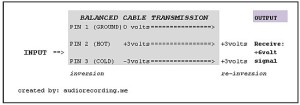
It shows a balanced audio transmission of a 3 volt signal. What happens is that this signal is present in the two conductors/wires of a balance cable. But the signal on the other conductor (“cold”) is inverted so the polarity is changed (-3volt). At the receiving end, it is re-inverted resulting in a doubled signal (+6volt signal) based on the above illustration.
Why a balance audio transmission is immune to noise? Any wires can pick up magnetic interference that can cause hiss, hum or noise. This magnetic or electrical interference can be coming from any other electronic/recording gears in your studio. Since the balance transmission consists of two wires, interference/noise is also pickup up equally between these two wires. See the illustration below:
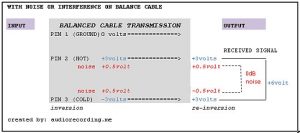
It shows an induced noise voltage of +0.5 volts equal on the two wires of a balance cable. At the receiving end during the re-inversion, this noise would cancel out:
Noise voltage at the receiving end of the balance cable = +0.5dB + (-0.5dB)
Noise voltage received= +0.5dB -0.5dB =0 Volts
What are examples of balance connectors commonly used in home recording?
1.) TRS male plug (tip-ring-sleeve, 2 carrying the signal and one ground)
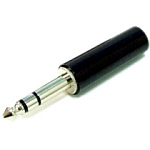
2.) XLR male connector
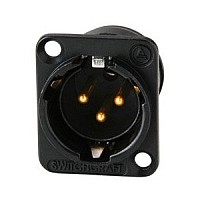
And below is a screenshot of a female XLR and female TRS connector:

Balanced audio is the standard audio connection system used in professional recording/music production. The biggest advantage is noise immunity and clean recording signal.
To have a “perfectly balanced” audio connection, it should fulfill the following requirements:
1.) The source audio is outputted using balance audio method.
2.) The male(input) connector to the source audio device should be using balance connectors.
3.) The cable transmitting the signal should be using balance audio transmission.
4.) The output connectors to the input (receiving) device should also be using balance audio method.
5.) The input device receiving the audio signal should be designed to received balanced audio.
In summary, the entire signal chain should be using balance audio connections. Single unbalance connectors in the signal chain can make everything unbalanced. Below is a good example of a perfect balance audio connection system. It illustrates how to connect M-audio Bx5a to an audio interface such as Saffire Pro 40.

The source audio is the analog main output of the Saffire Pro 40 audio interface. According to the manufacturer specification (which you should know by reading the manuals of your gear), the output is balanced with a TRS female connector. Meanwhile M-audio BX5a (the input/receiving device) also requires a balance input as shown with the TRS female connector label on the screenshot. Therefore to make everything balanced, two TRS male to male balance cable is required (because there are two monitors).
Unbalanced Audio and its connectors
Unlike balance audio, unbalance audio transmission only require one wire (the center conductor) and one ground. Since it’s only one wire carrying the signal, thus it is called unbalanced. This method is susceptible to induced noise and it will be received together with the original signal.

The noise would become worse as the cable length increase. It is why, most engineers in the recording studio or technicians setting up a live venue equipment would ensure that they using balance audio for very long cables.
Unfortunately, unbalance audio is found anywhere and mostly found in the consumer audio equipment. Example of unbalance connectors are:
1.) TS male plug (tip-sleeve)
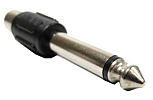
TS male only contains one black stripe on the plug while TRS contains two black stripes, this is how to spot the differences between TRS and TS male plugs. The TS female looks exactly the same with TRS female.
2.) RCA male and female plug
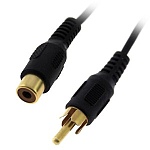
Stereo/Mono in relation to Balanced and Unbalanced
1.) Does TRS mean stereo and TS means mono?
Not accurate, this is a common misconception among beginners always associating a TRS plug with being a stereo plug. In fact, TRS connector is also used with “balanced” mono signals. TS is always used with mono but TRS can be used in either mono or stereo mode (refer to the next question for details). )
The origin of why TRS is often used with stereo is because of the popularity of the use of TRS jacks with stereo in consumer audio equipment. Example of these are found in CD players, iPods, computer soundcards and almost any other consumer audio/video equipment.
2.) If I use a balance connector (e.g. TRS); does it mean that all balanced audio transmitted are now in stereo?
No, transmitting a stereo signal on a single TRS cable can never be balanced. Try to look at this table to get a better understanding.
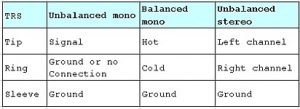
A single TRS can be commonly used in 3 ways. Either as unbalanced mono, balanced mono and unbalanced stereo. If you are using stereo with a single TRS, the mode of transmission is unbalanced. You need two TRS cables to make the entire system balanced. It is why in the above M-audio BX5a reference monitor example, two TRS cables are needed for a pair of monitors. Each of these TRS cables are carrying balanced mono signal. Two balanced mono signals from two TRS = balanced stereo output.
Why a stereo transmission cannot be balanced in a single transmission? Remember that stereo consist of left and right channel (two distinct mono signals). However the principle on balanced audio transmission only requires a single mono audio signal to travel on single balance cable with two conductors. The original mono on the hot conductor and the inverted mono on the cold conductor. Thus it takes two TRS cable to transmit a balanced stereo. The same holds true if you are using XLR.
Best practices on balanced and unbalanced audio
a.)Always use balanced audio transmission when recording and monitoring. Connect your instruments to your audio interface balanced input and your audio interface to studio monitors balanced input. You always have a clean signal even with long cables.
b.)Always use balanced mono when tracking or recording instruments. In some cases where recording needs to be in stereo, then use balance stereo recording (two TRS carrying two balanced mono). Never record using unbalanced mono or unbalanced stereo. These also require having recording gears capable of accepting balanced audio.
It’s why its not advisable to use PCI or onboard soundcards during recording because they are always unbalanced making them one of the common causes of noise in recordings. These unbalanced inputs are RCA, TRS stereo for line and microphone input. However there are PCI soundcards with balanced inputs and outputs that you can use such as Audiophile 192.
***********************
UPDATE: Thanks Tito for pointing out an example of balanced PCI soundcards, see the comment section below.
***********************
Modern USB/Firewire audio interface always accepts balanced audio so this should not be a problem.
c.) If you have an unbalanced output (from guitars for example because it is always using ¼ TS mono plug in a guitar cable); then you should use DI box. This DI box would convert the high impedance- unbalanced input to low impedance balanced output suitable for use with your audio interface preamps or mixers. Read more about DI in this article on beginner FAQ on DI boxes:
d.) Professional studio microphones used in recording/music production have XLR output. These are balanced output (check with manufacturer specifications) so you should connect them to the microphone preamp XLR input (balanced as well) for best performance.
e.) Never use adaptor plugs if you care having your entire signal chain on balanced. For example, one common mistake is using TRS connector (which can transmit balanced audio) with RCA adaptor. RCA is an unbalanced connector, thus making your signal chain becoming unbalanced.
If you need to convert, use DI box as an alternative as they deal with unbalanced to balanced audio very well without loss in signal quality or adding any noise.
Content last updated on August 27, 2012









5 Responses
Thanks for the correction, I edited the post. Cheers.
“It’s why its not advisable to use PCI or onboard soundcards during recording because they are always unbalanced”
But that’s not true.
There are PCI soundcards with balanced I/O, for example:
http://www.m-audio.com/products/en_us/Audiophile192.html
Happy Easter Brenny! Thanks for reading the article.
Very Good Article….Thanks EMERSON… Happy Easter.
Thank you, this is very helpful.